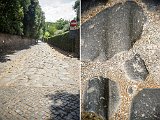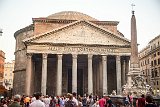
The Pantheon
The Royal Clipper docked early in the morning. As a result we got to our hotel way too early to check in. Apparently this was not unusual as the desk clerk said they would watch the luggage and gave us a map with a suggested walking tour until our room was ready. The first stop was the Pantheon. It is a former Roman temple which was dedicated honor all gods. It was converted to a Christian church dedicated to "St. Mary and the Martyrs" replacing all the statues of gods in the alcoves with statues of saints. :-) Since it has been in continuous use since ancient times, it is one of the best preserved Roman buildings. This picture shows the Pantheon along with its fountain topped by an Egyptian obelisk honoring the gods Isis and Serapis.
Image 1 of 33
The Pantheon
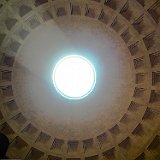
The Pantheon's Oculus
The main part of the Pantheon is it's circular rotunda. It is covered by a spherical concrete dome which is the largest unsupported dome in the world. In the center of the dome is a circular opening known as the oculus. This is the only source of light for the rotunda. Any rain falling through the hole is quickly drained away by a slanted floor. On April 21 (the legendary anniversary of the founding of Rome) light from the oculus goes through the door and lights up the entrance portico.
Image 2 of 33
The Pantheon's Oculus

The Trevi Fountain Panorama Collage.
Arguably the most famous fountain in the world, this fountain marks the terminus of the Virgo Acqueduct. There has always been a fountain here. The current fountain dates from the mid 18th century. It has been restored several times recently, mostly to remove pollution grime. Approximately 3000 Euros worth of coins are thrown into the fountain daily. The money is used to help Rome's needy. This picture illustrates the main problem with the fountain - it is too popular. I visited it twice -- midday and evening and both times there were too many people to get a good view. The upper picture is a panorama assembled from the best of my pictures. I found the eyes of the horses particularly impressive. The pupil is a hole carved into the eyeball. The lower picture in the collage is a close-up of one of the horses.
Image 3 of 33
The Trevi Fountain Panorama Collage.
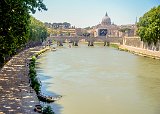
The Tiber River
I realize this is not a particularly good picture, but it gives me a place to add more commentary. It was a very hot day in Rome - the temperature was about 90. As we headed north from the Trevi Fountain we encountered a street vendor selling cold water and jumped at the opportunity. The water bottle was half frozen, but that turned out to be an advantage. The first couple of times we refilled the bottle the remaining ice cooled the fresh water. The next stop on the itinerary was the Spanish Steps. Unfortunately they were closed for renovation and the barricades ruined any pictures :-( While heading from there over to the Piazza Navona we stopped to have a quick lunch at a sidewalk café and diverted north to Ponte Umberto to view the Tiber River. This is a picture of the Tiber from that bridge looking west towards St. Peter's Basilica
Image 4 of 33
The Tiber River
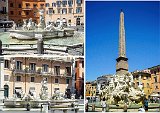
Piazza Navona Fountains
The Plazza Navona is a large public square notable for these three fountains. The square is built on the grounds of the ancient Circus Agonalis, dating from around 80AD. It took its current form beginning in the late middle ages when the city market was moved there. The fountains were added in 16th and 17th centuries. From north to south (and clockwise from the top left) the fountains are (1) Fontana del Nettuno (Fountain of Neptune) featuring Neptune fighting an octopus surrounded by sea nymphs and horses. (2) The largest, Fontana dei Quattro Fiumi (Fountain of the Four Rivers) representing the Nile, the Danube, the Ganges, and the Río de la Plata. The Egyptian obelisk on top of the fountain was brought from the Circus Maxentius. (3) Fontana del Moro ( Moor Fountain) with a Moor standing in a conch shell, wrestling with a dolphin, surrounded by four Tritons.
Image 5 of 33
Piazza Navona Fountains

Colosseum
This is the iconic must-see sight when visiting Rome. This panoramic picture was taken from across Via Celio Vibenna (the main road) from the Colosseum. I took it just after getting off of the bus from the hotel. The outside crowds were so large as to be oppressive. Fortunately the ticket/reservation system limited the tourists inside to a more tolerable level. Even more fortunately for me was meeting a gentleman who had misunderstood the advance ticket purchase procedures As a result he had extra tickets which he sold me at cost. I was surprised to see all the holes in the walls (clearly visible in the full sized image). Some of them were deliberate - needed by the builders for attaching their scaffolding for building higher up. Other holes are the result of vandalism - looting and scavenging of metal substructure.
Image 6 of 33
Colosseum
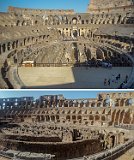
Inside the Colosseum
This collage shows two views of the arena inside the Colosseum. The lower one was taken from the west end on the lower deck. The upper one was taken from the east end on the upper deck
Image 7 of 33
Inside the Colosseum

Arch of Constantine
This arch, located just outside the Colosseum, celebrates Constantine's victory over Maxentius leading to his eventual emperorship. A 69' -high structure made up of 3 arches decorated with figures & battle scenes. It would be quite impressive were it not surrounded by so many other more impressive structures (such as the Colosseum). It ends up being overlooked. I took this picture from the elevated area where the Venus half of the Temple of Venus and Roma used to stand
Image 8 of 33
Arch of Constantine
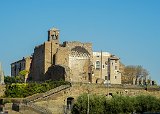
Temple of Venus and Roma
These temple remains are of the largest temple in ancient Rome. It was dedicated to Venus Felix (Venus the Bringer of Good Fortune) and Roma Aeterna (Eternal Rome).This picture, taken from the upper deck of the Colosseum, shows the remains of the half of the temple dedicated to Venus, which faced east overlooking the Colosseum. Originally there was a massive statue of Venus seated on a throne below the remaining quarter dome. Much of the half dedicated to Roma remains. It was symmetrically placed back to back with the Venus half and faces west overlooking the Forum.
Image 9 of 33
Temple of Venus and Roma
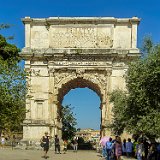
Arch of Titus
This 51' arch, located next to the Temple of Venus and Roma, was built to commemorate Titus's victories to include the sacking of Jerusalem. While we were sitting in the shade, resting from the heat, an English speaking school tour leader was explaining to his charges how this sacking of Jerusalem lead to the current Middle East situation. This arch served as the inspiration for the Arc de Triomphe in Paris. Again, while by itself this arch would be impressive, it seems to get lost among all the other sights around it.
Image 10 of 33
Arch of Titus
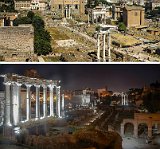
The Roman Forum
This collage shows two views of the Roman Forum. The upper was taken from a view point on Palatine Hill looking west and north. The three columns in the foreground are the remnants of the Temple of Castor and Pollux. It was build in 494 B.C. while Rome was ruled by kings and during the republic it was the meeting place for the Roman Senate. The arch immediately above the columns is dedicated to emperor Septimius Severus. The lower picture was taken about 10 pm from the Capitoline Hill looking east. The columns on the left are remnants of the Temple of Saturn which in later years doubled as the Roman treasury. The shorter column just to the right is dedicated to Phocas, the eastern Roman Emperor. Dating from 608 A.D. this column was the last structure added to the Forum. The columns in distant center are from the Temple of Antoninus and Faustina (141 A.D.) which have since been incorporated into the church of San Lorenzo in Miranda. In the distance on the right are the three columns from the Temple of Castor and Pollux The top of the Colosseum is visible in the far distance just right of center.
Image 11 of 33
The Roman Forum
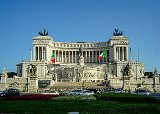
Vittoriano Monument
This monument goes by many names: Vittoriano Monument, Altare della (Altar of the Fatherland), and Monumento Nazionale a Vittorio Emanuele II (National Monument to Victor Emmanuel II) was built between 1885 and 1911 to honor of Emanuele II, the first king of Italy. Among other things, it holds the Italian Tomb of the Unknown Soldier (along with an eternal flame) and the flags of all disbanded units of the Italian armed forces and stricken naval ships. When a unit or ship is reactivated it receives its colors from this monument. Because it is so bright white and boxy, the monument is the derided by many. At least one guide to the city states " from its terraces you can enjoy the best views over the city - not least because the monument itself no longer intrudes on the skyline."
Image 12 of 33
Vittoriano Monument

Vatican Museums
This collage shows a few of the works on display in the Vatican Museums. Counter clockwise from the top left are (1) The School of Athens fresco featuring Leonardo da Vinci as Plato in the center and Michelangelo leaning on his elbow at the base of the stairs, (2) Perseus Triumphant holding the severed head of the Medusa, (3) the Nile (god) recumbent, (4) The Egyptian king Ptolemy Philadelphus, (5) The ceiling of the Gallery of Maps (6) Frescos on the ceiling of Hall of the Muses representing Apollo and the Muses as the inspirers of the arts, and (7) Sarcophagus St Helena mother of Constantine the Great,
Image 13 of 33
Vatican Museums
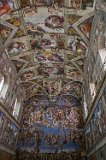
The Sistine Chapel Ceiling
No pictures were allowed to be taken in the Sistine Chapel. I have included this one that I downloaded from Wikipedia. Due to all the tourists the chapel was quite loud, even with signs in several languages requesting respect&silence and the guards constantly requesting quiet. Similarly the "no pictures" request was regularly being ignored :(. Despite the tourist rudeness, the chapel was awe inspiring.
Image 14 of 33
The Sistine Chapel Ceiling
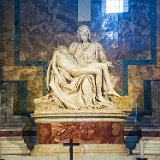
Michelangelo's Pietà
According to instructions in a guide book one can avoid the crowds entering St. Peter's by going out a publicly available 'back door' from of the Sistine Chapel, This route leads directly to the basilica. Immediately on your right after entering is the Chapel of the Pietà, so renamed after the sculpture was moved there in 1749. This is a picture of it. Unfortunately it needs to be protected from vandals by bulletproof glass which in my opinion detracts from the effect
Image 15 of 33
Michelangelo's Pietà
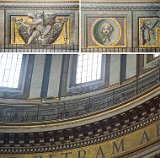
The Dome of St. Peter's Basilica
As is visible in the lower picture in this collage, visitors are allowed to go up the dome of St. Peter's (notice the people behind the fence just above the red and gold stripe). There is a sign to an elevator or stairs on the far right when you enter the main door. The elevator takes you up to the main roof of the Basilica from where a short flight of steps takes you into the dome's gallery . There are additional stairs to go all the way to the top, but considering the heat and our age, we did not go beyond the gallery. The top two pictures are typical mosaics lining the outer wall.
Image 16 of 33
The Dome of St. Peter's Basilica

St. Peter's Square
This is a panoramic view of St. Peter's Square as seen from the entrance to the basilica. The Egyptian obelisk in the center predates the square, having been moved to its position some 70 years earlier. There are circular stones set in the pavement marking where the shadow falls on noon on the day the Sun enters each zodiac sign. The northern (left) fountain also predates the square by about 40 years. However the southern (right) fountain wasn't added until the square was completed.
Image 17 of 33
St. Peter's Square

St Peter's Square From The Dome
Since I was unable to climb to the top of the dome I downloaded this picture from Wikipedia to show myself what I missed. From this viewpoint one can clearly make out the obelisk and fountains. The colonnades on either side consist of 4 rows of 30ft columns topped by 140 statues of saints. Also visible are the pattern in the cobblestones. Finally, in the foreground you see 13 statues - Christ in the center with John the Baptist to his right the remaining ones are 11 of his apostles. (St. Peter is missing as he and St. Paul have statues on the square below)
Image 18 of 33
St Peter's Square From The Dome
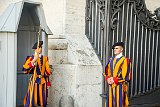
The Papal Swiss Guard
Established in 1506, the Papal Swiss Guard is the military of Vatican City. It is one of the world's oldest military units in continuous operation. New guard recruits must be unmarried Swiss Catholic males between 19 and 30 years of age who have completed basic training with the Swiss Armed Forces. The guard has two missions: posting the ceremonial guard and assuring the safety of the Pope. This picture shows a pair guards at a entrance on the side of St. Peter's Basilica to the non-public areas of Vatican City. They are in their renaissance inspired yellow, blue and red uniforms. Urban legions to the contrary, the uniforms were NOT designed by Michelangelo.
Image 19 of 33
The Papal Swiss Guard

The Bernini Fountain In St. Peter's Square
While leaving St. Peter's I took this picture of the southern Bernini Fountain. It was built from 1667-77 to closely resemble the northern (Maderno) fountain. In addition to the obelisk you can also see the colonnades with the some of the statues of saints above.
Image 20 of 33
The Bernini Fountain In St. Peter's Square
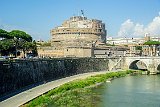
Castel Sant'Angelo
While crossing the Tiber I took this picture of The Mausoleum of Hadrian, usually known as Castel Sant'Angelo. It under the orders of Emperor Hadrian as a mausoleum for himself and his family. The building was later used by the popes as a fortress and castle, and is now a museum. it was once the tallest building in Rome.
Image 21 of 33
Castel Sant'Angelo
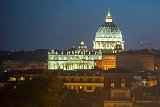
Pincian Hill
After resting for a while at our hotel, we asked the desk clerk for suggestions as to where to go. Her recommendation was Pincian Hill which was about 20 minutes away by bus. While this hill was not one of the original seven hills, it is within the walls of Rome. There is a balustraded overlook at the top with excellent views to the west and south. This is a longish exposure of St. Peters Basilica from there.
Image 22 of 33
Pincian Hill
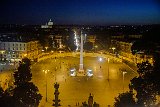
Piazza del Popolo
The Pincian Hill overlooks the Piazza del Popolo which appears to mean Square of the People but its name is actually derived from poplar trees. The square was designed in the early 1800s In its center stands the Flaminio Obelisk, a 67' Egyptian obelisk dating from the 13th century B.C. This longish exposure picture was taken from Pincian Hill overlook. Note all the kids on the upper left side of the obelisk.
Image 23 of 33
Piazza del Popolo
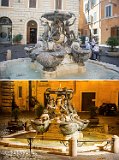
Fontana delle Tartarughe
Wikipedia lists 50 monumental fountains in Rome with over 2000 fountains total. Big or small, they are attractive both in the daylight and at night. These pictures are of the Fontana delle Tartarughe (The Turtle Fountain) which was located along a non descript 'back alley' route we walked to catch a bus. I took the upper picture about 10 am one morning, the lower about 10pm. Only later while researching this description did I learn its name, and that it dates from the late 16th century with the turtles being added some seventy years later
Image 25 of 33
Fontana delle Tartarughe

Saint Sebastian at the Catacombs
Following directions from our hotel's front desk we took a bus to the planning to go to Catacombs of St. Callixtus. Unfortunately we missed the stop and since the road (Appian Way) was so narrow the driver would not let us off. Other passengers on the bus told us that there was another catacomb a bit further down, so we got off there. These were the Catacombs of San Sebastiano. We took a guided tour of them. Unfortunately no pictures were allowed inside the catacombs. This is a picture of San Sebastiano ad Catacumbas (Saint Sebastian at the Catacombs), the church built above them. The entrance to the catacombs is through the little arch immediately to the right of the church proper. In addition the being a church, they also had a small gift shop, carryout food operation, and rented bicycles to ride down the Appian Way.
Image 26 of 33
Saint Sebastian at the Catacombs
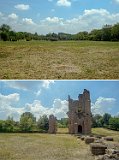
Circus of Maxentius
The Circus Maximus in down town Rome is arguably the most famous of the Roman circuses. However considering that it is just a big vacant block, it was a bit disappointing. However a short distance down the Appian Way from the Catacombs of San Sebastiano I came across this Circus of Maxentius which is more impressive. While not as large as Maximus (550 yards vs 680 yards long) , there are still structures on the site, and I could easily imagine chariots racing around. It dates from the very early fourth century. These pictures show (top) the view looking east from the entrance and (bottom) the ruins of the entrance gates.
Image 27 of 33
Circus of Maxentius

Monk Parakeets
As I was walking down the Appian Way I kept hearing these birds chirping away in the trees. I thought at the time they sounded like the wild parrots I had heard in San Francisco. A little while later I spied the noisemakers in a tree, and guess what - they were parrots - or at least parakeets. As I later learned they were Monk Parakeets, one of two independent breeding populations (the other being rose-ringed parakeets). They probably escaped / were released in the late 1970s and successfully adapted to the Roman environment.
Image 29 of 33
Monk Parakeets
Terrazza del Gianicolo
After returning from the Catacombs and the Appian Way, we rested a while and then took an evening excursion. Our first stop was Terrazza del Gianicolo which has some excellent views of downtown Rome as can be seen in this panorama.
Image 30 of 33
Terrazza del Gianicolo
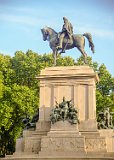
Monument to Garibaldi
In the Terrazza del Gianicolo is a monument to Giuseppe Garibaldi. While I had been aware of Garibaldi's role in the liberation of several South American countries, I had been unaware of his role in the unification of Italy. This monument to him memorializes that role and describes his return to Italy. It is located on the Janiculum hill (not one of the original seven hills of Rome) to the west of down town Rome. The monument is located in the middle of the Terrazza del Gianicolo. at the top of the hill. In Roman times the hill was a center for the cult of the god Janus (after whom January is named).
Image 31 of 33
Monument to Garibaldi
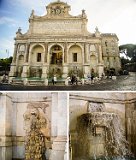
The Fontana dell'Acqua Paola
We walked down the Janiculum hill. About half way down we came upon this monumental fountain. it marks the terminus of the Acqua Paola aqueduct and was built in 1612. The aqueduct and fountain were restored and built by Pope Paul V. It was the first major fountain to the west of the Tiber river. The fountain is named after him (Paola) The upper picture in this collage provides a complete view of the fountain. The lower two pictures show details of the water outflows. Since this fountain is powered only by gravity, it does not have the upward jets of modern fountains.
Image 32 of 33
The Fontana dell'Acqua Paola
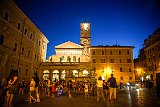
Piazza di Santa Maria in Trastevere
The destination for our walk down from Janiculum was this piazza. It was noted in our guide books as being photogenically lit in the evening. We arrived before dark and had dinner in one of the cafés as the sun set. This picture is of the lit piazza after dark. The fountain all the people are sitting on is believed to be the oldest fountain in Rome, dating back, according to some sources, to the 8th century. According to the legend, on the Christmas Eve a fountain of oil appeared miraculously in front of the church, which as a result was given the name "Santa Maria in fontibus." It was reconstructed in 1499 and 1604, 1873, and 1930. It is fed by the Acqua Paola. The church is the background is the Basilica of Santa Maria in Trastevere. From here we took a taxi to Piazza del Campidoglio on Capitoline Hill, from where I took some nighttime pictures of the Roman Forum area (One of which is in a previous collage)
Image 33 of 33
Piazza di Santa Maria in Trastevere



